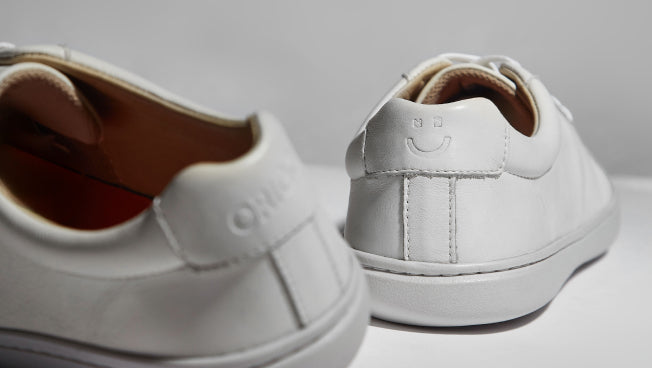
Animal leather has been used for thousands of years to make shoes. In fact, one of the earliest examples of leathercraft was a 3,500-year-old shoe made from a single piece of leather discovered in a cave in southern Armenia.
However, the leather used in mass-manufactured shoes is not made and processed the way it used to be back in the days of our ancestors. Instead of natural substances, such as tannins from tree bark, harmful chemicals are now used for tanning most of the world’s leather.
So-called “vegan” leather alternatives have been around for many years. However, most of the faux leather used to make shoes is composed of polyurethane (PU) and polyvinyl chloride (PVC), plastics derived from fossil fuels. While making PU and PVC shoes does not involve harming animals, it indirectly harms wildlife, fish and humans when its toxins enter the food chain by going into the air, ground and waterways.
Fortunately, vegans and individuals who want cruelty-free and sustainable footwear have a better option than plastic: cactus leather.
What Is Cactus Leather?
Prickly pear cacti, native to the Americas, have thick, flat leaves covered in prickles, hence its name. It has many applications. In desert regions, prickly pear is used as animal fodder. Its pads or leaves are edible, often used in Mexican cuisine, and also a biofuel source. More recently, prickly pear has been used to make cactus leather for footwear.
Compared to plastic leather, cactus leather looks and feels more similar to animal leather. In addition, it’s highly resistant to bacteria, easy to clean and difficult to stain. The cactus leather manufacturing process also impacts the environment less than making PU and PVC.
How Cactus Leather Is Made
The cactus leather manufacturing process involves several steps.
First, prickly pear cacti are planted. Once fully grown, their mature leaves are harvested. Due to prickly pear cacti being perennials, they only need to be planted once and can be harvested every six to eight months for at least eight years.
The next step in the cactus leather process is to dry the leaves under the sun for three days. Afterward, proteins and fibers are extracted from the leaves to create a bio resign, which is then used to coat a carrier or backing.
The final product is a buttery soft leather that is as flexible, breathable and versatile as high-quality animal-derived leather.
Is Cactus Leather Better for the Environment Than PU and PVC Leather?
The simple answer is yes. The production of PU and PVC causes harmful toxins to be released into the environment. Meanwhile, the cactus leather manufacturing process is less wasteful and does not directly or indirectly harm wildlife or humans.
Some believe that PU leather is a sustainable choice because it is long-lasting and does not leach toxins into the ground. However, at the end of its life, it breaks down into tiny pieces of microplastic that eventually end up in waterways, harming wildlife and polluting the oceans.
Meanwhile, research shows that PVC is even more damaging to the environment and human health. According to a report by The Center for Health, Environment & Justice (CHEJ), PVC is one of the most hazardous products ever made.
PVC is mixed with different additives, depending on the intended application. These include asbestos, a known carcinogen, and mercury, a neurotoxin. Making PVC leather results in these and other harmful chemicals being released into the environment, building up in the surrounding ecosystems.
On the other hand, making leather from cactus plants has the following advantages, proving that it’s a better choice for the planet than plastic leather.
- Less Water Used: Prickly pear cacti farms do not require irrigation systems, as these plants can survive off occasional rainfall. Growing the cacti needs very little water. For instance, it takes 5,283 gallons of water to grow 2.2 lb of cotton. In contrast, prickly pear cacti need about 53 gallons to produce the same amount of material.
- Less Energy Required: Tanning cactus leather only requires leaving the leaves out under the sun to dry for at least three hours. There is no need for grow lights, tent heaters or other equipment for this step in the process of making leather from cactus plants.
- Zero Animals Harmed: No animal products or byproducts are used in the cactus leather process.
- Does Not Contribute to Landfill Waste: There are several types or grades of cactus leather, and some contain more biodegradable materials than most. Desserto, a pioneer in the cactus leather industry, offers cactus leather that is up to 92 percent biodegradable.
Additionally, like all plants, prickly pear cacti are carbon sinks. This means they absorb and store more carbon dioxide from the atmosphere than they release. Carbon sinks restore balance to the climate by absorbing carbon, which is a heat-trapping gas, thus helping keep temperatures stable.
Most plants release carbon dioxide back into the atmosphere when they start to decay. However, cacti are unique in that when they die, some of the carbon dioxide they’ve absorbed mixes with the calcium ions in their roots and pads to eventually form solid calcium carbonate or calcite. Simply put, the carbon dioxide is turned into calcite and stored in the soil instead of sent back into the atmosphere.
Cactus Leather Footwear: Sustainability and Style
With eco-friendly options such as cactus leather now available, it’s hard to imagine going back to shoes made of plastic and rubber. Cactus leather footwear is not just gentle on the environment. It can also be stylish in the hands of a talented designer.
At Origo Shoes, we are passionate about combining sustainability and style. Our minimalist footwear for men, women and children is mindfully made from nature-derived materials such as cacti. To further reduce our environmental impact, we donate to One Tree Planted for every pair sold.
Learn more about Origo Shoes by reading our FAQs.






